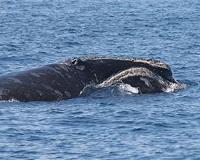 |
Washington DC (SPX) May 02, 2011 In a recent study to be published in the peer-reviewed open-access journal PLoS ONE, Dr. Elliott Hazen and colleagues found that oceanographic and prey measurements can be used to identify beaked whale foraging habitat. The research team from Duke University, Woods Hole, and the Naval Undersea Warfare Center listened for foraging beaked whales and measured ocean features and distributions of prey off the east coast of Andross Island in the Bahamas. Their manuscript provides evidence that these difficult to study deep-diving creatures use specific ocean features such as salinity and temperature to find their prey. This is the first study describing their distribution and feeding habitat relative to ocean features Blaineville's beaked whales regularly dive over 1000 meters for over an hour in search of prey which varies from 400-1000 meters. The shy and elusive toothed whales feed primarily on fish and squid in the ocean's deep scattering layer, an important prey resource for many species throughout the world's oceans. In addition, Blaineville's beaked whales are listed as data deficient by the IUCN, and very little is currently known about the ecology of these creatures. Beaked whale species are thought to be sensitive to noise arising from certain human activities; in 2000, beaked whale strandings were observed coinciding with naval sonar exercises in the Bahamas. Understanding the distribution and behavior of these species is important to minimize harmful impacts from human uses of the ocean. Researchers worked aboard the R/V Revelle, an 86-meter vessel out of Scripps Institute of Marine Science. Fisheries acoustics data found scattering layers of prey on the western edge of the tongue of the ocean were denser than those at the eastern edge. Eighty-two bottom-mounted hydrophones also recorded increased foraging activity on the western edge of the basin. The hydrophone range at AUTEC allowed for unprecedented measurements of the habitat and behavior of these elusive predators providing "necessary insight into how beaked whales interact with their environment". Studies on harbor porpoises and bottlenose dolphins have shown how modeling habitat can be a powerful tool to inform spatially adaptive management of pelagic predators (Bailey and Thompson 2009, Embling et al. 2009). Further work is necessary to determine whether this foraging model could be extrapolated to other seasons or populations. Embling C, Gillibrand P, Gordon J, Shrimpton J (2009) Using habitat models to identify suitable sites for marine protected areas for harbour porpoises (Phocoena phocoena). Biological Conservation 143: 267-279. Bailey H, Thompson P (2009) Using marine mammal habitat modelling to identify priority conservation zones within a marine protected area. Marine Ecology Progress Series 378: 279-287. Citation: Hazen EL, Nowacek DP, St. Laurent L, Halpin PN, Moretti DJ (2011) The Relationship among Oceanography, Prey Fields, and Beaked Whale Foraging Habitat in the Tongue of the Ocean. PLoS ONE 6(4): e19269. doi:10.1371/journal.pone.0019269
Share This Article With Planet Earth
Related Links Public Library of Science Follow the Whaling Debate
 Why Right Whales Linger in the Gulf of Maine
Why Right Whales Linger in the Gulf of MaineWoods Hole MA (SPX) Apr 28, 2011 As they might with most endangered animals, scientists consider the whereabouts and activities of right whales extremely important. "It is helpful to know where they go, why they go there and what they do when they're there," says Mark F. Baumgartner of the biology department at the Woods Hole Oceanographic Institution (WHOI). Baumgartner and his colleagues studied the behavior of right wh ... read more |
|
| The content herein, unless otherwise known to be public domain, are Copyright 1995-2010 - SpaceDaily. AFP and UPI Wire Stories are copyright Agence France-Presse and United Press International. ESA Portal Reports are copyright European Space Agency. All NASA sourced material is public domain. Additional copyrights may apply in whole or part to other bona fide parties. Advertising does not imply endorsement,agreement or approval of any opinions, statements or information provided by SpaceDaily on any Web page published or hosted by SpaceDaily. Privacy Statement |